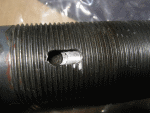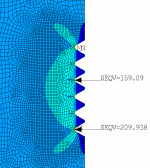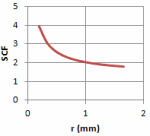|
 If the people of Pisa had access to Alex Tomanovich’s footing analysis calculation do you think they would have built that famous ‘leaning’ tower? When you download calculations from the ExcelCalcs repository of solved problems
you access a live document encompassing years of knowledge and best
practise. Our documents are prepared by working engineers not focused
on the academic pursuit of theory but on practical solutions to solve
common engineering problems. Best still you’ll always find a ‘Forum Link’
so you can ask the calculation author any question if there is
something in it you cannot understand. The ExcelCalcs repository saves
you time, taps into expert knowledge and helps you avoid making
mistakes. If the people of Pisa had access to Alex Tomanovich’s footing analysis calculation do you think they would have built that famous ‘leaning’ tower? When you download calculations from the ExcelCalcs repository of solved problems
you access a live document encompassing years of knowledge and best
practise. Our documents are prepared by working engineers not focused
on the academic pursuit of theory but on practical solutions to solve
common engineering problems. Best still you’ll always find a ‘Forum Link’
so you can ask the calculation author any question if there is
something in it you cannot understand. The ExcelCalcs repository saves
you time, taps into expert knowledge and helps you avoid making
mistakes.
We recognise that preparing a repository
calculation takes a good deal of knowledge of the subject matter and a
good deal of effort in laying out the calculation in a readily useable
form. So if you have a spreadsheet to share with us we’ll be delighted to share all ours with you. If you don’t have a calculation to share then just $90 per year gives you full access to our repository calculations and a commercial license for XLC our essential engineering addin for Excel.
Take a look at the Repository News section below which features new
calculations uploaded since our last newsletter, you’ll find something
for civil engineers, structural engineers and mechanical engineers.
This
year we intend to increase the user base by a factor of 10 so we
appreciate all efforts to spread the word about ExcelCalcs. Thank you
for forwarding emails to colleagues, adding links to us on your
websites and blogs.
Repository News
 SCF circular shaft with keyseat.xlsx SCF circular shaft with keyseat.xlsx

A stress concentration is the phenomenon for which stress in a body
becomes much more than the nominal stress due to abrupt change in cross
section or presence of discontinuities. 'Stress concentration' (often
called stress raisers or stress risers) is a location in an object
where stress is concentrated. Fatigue cracks always start at stress
raisers, so removing such defects increases the fatigue strength. This
calculation was used in our consultancy work when we were asked to
consider the fatigue implications of adding a keyslot feature in the
ends of an actuator arm on a tilting train. Our consultancy work also
undertook a finite element analysis of the stress raiser and the
calculation was used to validate the results.
 BUOYANCY ANALYSIS FOR CONCRETE PIT OR TANK BUOYANCY ANALYSIS FOR CONCRETE PIT OR TANK

"BUOYANCY.xls" is a spreadsheet program written in MS-Excel by Alex
Tomanovich for the purpose of performing a buoyancy analysis, checking
the resistance to flotation, for either an open or buried/enclosed
rectangular concrete pit or tank. This program is based on the
Archimedes Principal on buoyancy which is stated as follows: "Any
object, wholly or partially immersed in a fluid, is buoyed up by a
force equal to the weight of the fluid displaced by the object". Thus,
the volume of water displaced by the object multiplied times the unit
weight of water is equal to the buoyant force.
 Light-weight Composite Beam Design Light-weight Composite Beam Design

Consider a cantilever beam with a load applied at the free end. The
applied load creates a bending moment which is a maximum at the fixed
end, and a shear force along the length of the beam. In a sandwich
panel these forces create tension in the upper skin and compression in
the lower skin. The core spaces the facing skins and transfers shear
between them to make the composite panel work as a homogeneous
structure. The following beam loading conditions can be selected using
a drop down combo box.
L1) Simple Support with Uniform Load Distribution
L2) Both Ends Fixed with Uniform Load Distribution
L3) Simple Support with Central Load
L4) Both Ends Fixed with Central Load
L5) Cantilever with Uniform Load Distribution
L6) Cantilever with Load at End
L7) Cantilever with Triangular Load Distribution
The panel is checked against critical intra-cell buckling, critical
face wrinkling stress, allowable tensile stress on face, core shear
stress and deflection.
 Composite Panel Calculations.xlsx Composite Panel Calculations.xlsx

A similar calculation considers a composite panel simply supported on
four edges subject to a uniformly distributed load. It makes the same
checks as the beam calculation but because plate theory is a bit more
involved than beam theory it uses a number of charts to determine
multipliers and coefficients for the calculation. Following methods
described on this site to automatically read lookup tables performing
this calculation is just as quick as the beam calculation spreadsheet.
This calculation was recently used in our consultancy work when we were
asked to about a light weight floor solution for an urban tramway floor.
 RECTANGULAR SPREAD FOOTING ANALYSIS RECTANGULAR SPREAD FOOTING ANALYSIS

"FOOTINGS.xls" is a spreadsheet program written in MS-Excel by Alex
Tomanovich for the purpose of analysis of rigid rectangular spread
footings with up to 8 total piers, and for either uniaxial or biaxial
resultant eccentricities. Overturning sliding, and uplift stability
checks are made when applicable, and resulting gross soil bearing
pressures at the four (4) corners of the footing are calculated. The
maximum net soil bearing pressure is also determined.
|















